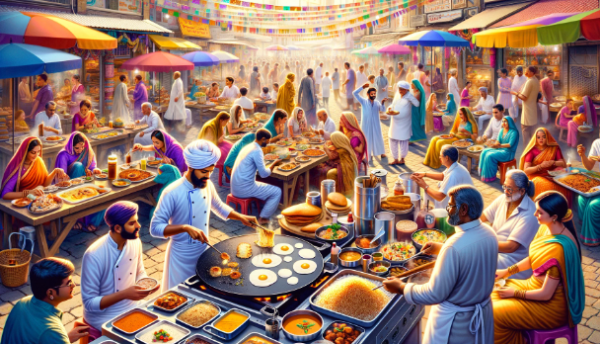
Culinary Experiences
"Flavourful Odyssey: Exploring the Rich Culinary Heritage of South Asia, with a Focus on India"
The culinary experiences of South Asia, particularly in India, are an extravagant journey through a rich tapestry of flavors, aromas, and textures. This region, known for its diverse cultures, languages, and histories, offers a gastronomic adventure that is as varied as its many states and communities.
1. Diverse Regional Cuisines:
- North India: Known for its hearty, rich gravies and tandoori cooking. Popular dishes include Butter Chicken, Rogan Josh, and a variety of bread like Naan and Parathas.
- South India: Famous for its use of rice, lentils, and coconut. Iconic dishes include Dosa, Idli, Sambar, and Hyderabadi Biryani.
- East India: Renowned for its sweets like Rasgulla and Sandesh, and seafood delicacies. Bengali cuisine, with its use of mustard oil and Panch Phoron (five-spice blend), is a highlight.
- West India: Offers a range of flavors from the Goan Vindaloo to Gujarati Dhokla and the street food of Mumbai like Vada Pav.
2. Street Food Culture:
- Street food is an integral part of Indian cuisine, offering an array of quick, tasty, and affordable options. Chaats, Pani Puri, Bhel Puri, and Kebabs are just a few examples of the vast street food variety.
3. Spices and Flavors:
- Indian cuisine is known for its masterful use of spices. Each dish can include a unique blend, from common spices like turmeric, cumin, and coriander to more exotic ones like saffron and asafoetida.
4. Vegetarianism and Diverse Dietary Practices:
- With a significant portion of the population being vegetarian, there's a vast array of vegetarian dishes, making Indian cuisine a paradise for vegetarians.
5. Festive Foods and Sweets:
- Festivals in India are marked by special foods. Sweets like Laddoos, Jalebis, and Gulab Jamuns are synonymous with celebrations.
6. Traditional Dining Etiquette:
- Traditional eating often involves sitting on the floor and eating with hands, believed to enhance the dining experience by engaging all senses.
7. Influence of Ayurveda and Regional Ingredients:
- Many Indian dishes incorporate principles from Ayurveda, emphasizing the balance of flavors and nutritional benefits. The use of local and seasonal ingredients is also a hallmark.
8. Global Influences and Fusion Cuisine:
- Indian cuisine has absorbed influences from various invaders and traders over centuries, like the Mughals and the British, leading to a fusion of flavors.
9. Gourmet and Fine Dining Experiences:
- Upscale restaurants across India offer gourmet experiences, showcasing traditional dishes with modern interpretations.
10. Cooking Techniques:
- Techniques vary widely, from slow-cooked stews to quick stir-fries, with each region having its unique methods.
Experiencing Indian Cuisine: To truly experience Indian cuisine, one must go beyond just eating the food. It's about understanding the history behind dishes, the significance of ingredients, and the cultural stories that each recipe holds. Food tours, cooking classes, and local dining experiences are great ways to delve deeper into this rich culinary heritage.
In conclusion, the culinary experiences in India are not just about food; they're an exploration of a vibrant cultural landscape, where every bite tells a story and every flavor takes you on a journey.

Enquire Now